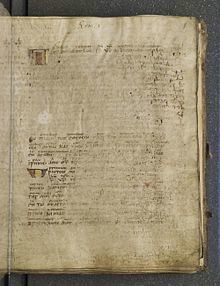Name Boernerianus Text Pauline epistles Script Greek/Latin diglot | Sign G Date 850-900 Found Abbey of Saint Gall | |
 | ||
Now at Saxon State Library Dresden Similar Codex Claromontanus, Codex Laudianus, Codex Boreelianus, Codex Zacynthius, Codex Guelferbytanus A | ||
Codex Boernerianus, designated by Gp or 012 (in the Gregory-Aland numbering), α 1028 (von Soden), is a small New Testament codex, measuring 25 x 18 cm, written in one column per page, 20 lines per page. Dated paleographically to the 9th century. The name of the codex derives from Boerner, to whom it once belonged. The manuscript is lacunose.
Contents
Description
The manuscript contains the text of the Pauline epistles (but does not contain Hebrews) on 99 vellum leaves. The main text is in Greek with an interlinear Latin translation inserted above the Greek text (in the same manner as Codex Sangallensis 48).
The text of the codex contains six lacunae (Romans 1:1-4, 2:17-24, 1 Cor. 3:8-16, 6:7-14, Col. 2:1-8, Philem. 21-25). Quotations from the Old Testament are marked in the left-hand margin by inverted commas (>), and Latin notation identifies a quotation (f.e. Iesaia). Capital letters follow regular in stichometric frequency. This means codex G was copied from a manuscript arranged in στίχοι. The codex sometimes uses minuscule letters: α, κ, ρ (of the same size as uncials). It does not use Spiritus asper, Spiritus lenis or accents.
The Latin text is written in minuscule letters. The shape of Latin letters: r, s, t is characteristic of the Anglo-Saxon alphabet.
The Codex does not use the phrase ἐν Ῥώμῃ (in Rome). In Rom 1:7 this phrase was replaced by ἐν ἀγαπῃ (Latin text – in caritate et dilectione), and in 1:15 the phrase is omitted (in both Greek and Latin).
After the end of Philemon stands the title Προς Λαουδακησας αρχεται επιστολη (with interlinear Latin ad Laudicenses incipit epistola), but the apocryphal epistle is lost.
Text
The Greek text of this codex is a representative of the Western text-type. Aland placed it in Category III.
The section 1 Cor 14:34-35 is placed after 1 Cor 14:40, just like other manuscripts of the Western text-type (Claromontanus, Augiensis, 88, itd, g, and some manuscripts of Vulgate.
The Latin text has some affinity with Liber Comicus.
Romans 6:5 αλλα και της αναστασεως ] αμα και της αναστασεως Romans 12:11 κυριω ] καιρω Romans 15:31 διακονια ] δωροφορια — B D Ggr Romans 16:15 Ιουλιαν ] Ιουνιαν — C. Galatians 6:2 αναπληρωσατε ] αναπληρωσετε — B 1962 it vg syrp,pal copsa,bo goth eth Philippians 3:16 τω αυτω στοιχειν ] το αυτο φρονειν, τω αυτω συνστοιχειν — supported by F Philippians 4:7 νοηματα ] σωματα — F GIn Romans 8:1 it reads Ιησου (as א, B, D, 1739, 1881, itd, g, copsa, bo, eth). The Byzantine manuscripts read Ιησου μη κατα σαρκα περιπατουσιν αλλα κατα πνευμα.
It does not contain the ending Romans 16:25-27, but it has blanked space at Romans 14:23 for it.
In 1 Corinthians 2:1 it reads μαρτυριον along with B D P Ψ 33 81 104 181 326 330 451 614 629 630 1241 1739 1877 1881 1962 1984 2127 2492 2495 Byz Lect it vg syrh copsa arm eth. Other manuscripts read μυστηριον or σωτηριον.
In 1 Corinthians 2:4 it reads πειθοις σοφιας (plausible wisdom) along with
In 2 Corinthians 2:10 the Greek text reads τηλικουτου θανατου, along with the codices: א, A, B, C, Dgr, K, P, Ψ, 0121a, 0209, 0243, 33, 81, 88, 104, 181, 326, 330, 436, 451, 614, 1241, 1739, 1877, 1881, 1962, 1984, 1985, 2127, 2492, 2495, Byz.
The Old Irish Poem in the Codex Boernerianus
On folio 23 verso at the bottom is written a verse in Old Irish which refers to making a pilgrimage to Rome:
Stokes and Strachan's translation:
To go to Rome, much labour, little profit: the King whom thou seekest here, unless thou bring him with thee, thou findest him not.
Much folly, much frenzy, much loss of sense, much madness (is it), since going to death is certain, to be under the displeasure of Mary's Son.
Bruce M. Metzger in his book Manuscripts of the Greek Bible quotes this poem, which seems to have been written by a disappointed pilgrim.
History
The codex was probably written by an Irish monk in the Abbey of St. Gall, Switzerland between 850-900 A.D. Ludolph Kuster was the first to recognize the 9th century date of Codex Boernerianus. The evidence for this date includes the style of the script, the smaller uncial letters in Greek, the Latin interlinear written in Anglo-Saxon minuscule, and the separation of words.
In 1670 it was in the hands of P. Junius at Leiden. The codex got its name from its first German owner, University of Leipzig professor Boerner, who bought it in the Dutch Republic in the year 1705. It was collated by Kuster, described in the preface to his edition of Mill's Greek New Testament. The manuscript was designated by symbol G in the second part of Wettstein's New Testament. The text of the codex was published by Matthaei, at Meissen, in Saxony, in 1791, and supposed by him to have been written between the 8th and 12th centuries. Rettig thought that Codex Sangallensis is a part of the same book as the Codex Boernerianus.
During World War II, the codex suffered severely from water damage. Thus, the facsimile, as published in 1909, provides the most legible text. Some scholars believe that, originally, this codex formed a unit with the Gospel manuscript Codex Sangallensis 48 (Δ/037). Boernerianus is housed now in the Saxon State Library (A 145b), Dresden, Germany, while Δ (037) is at Saint Gallen, in Switzerland.
